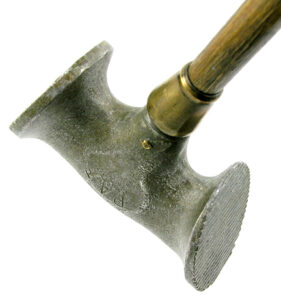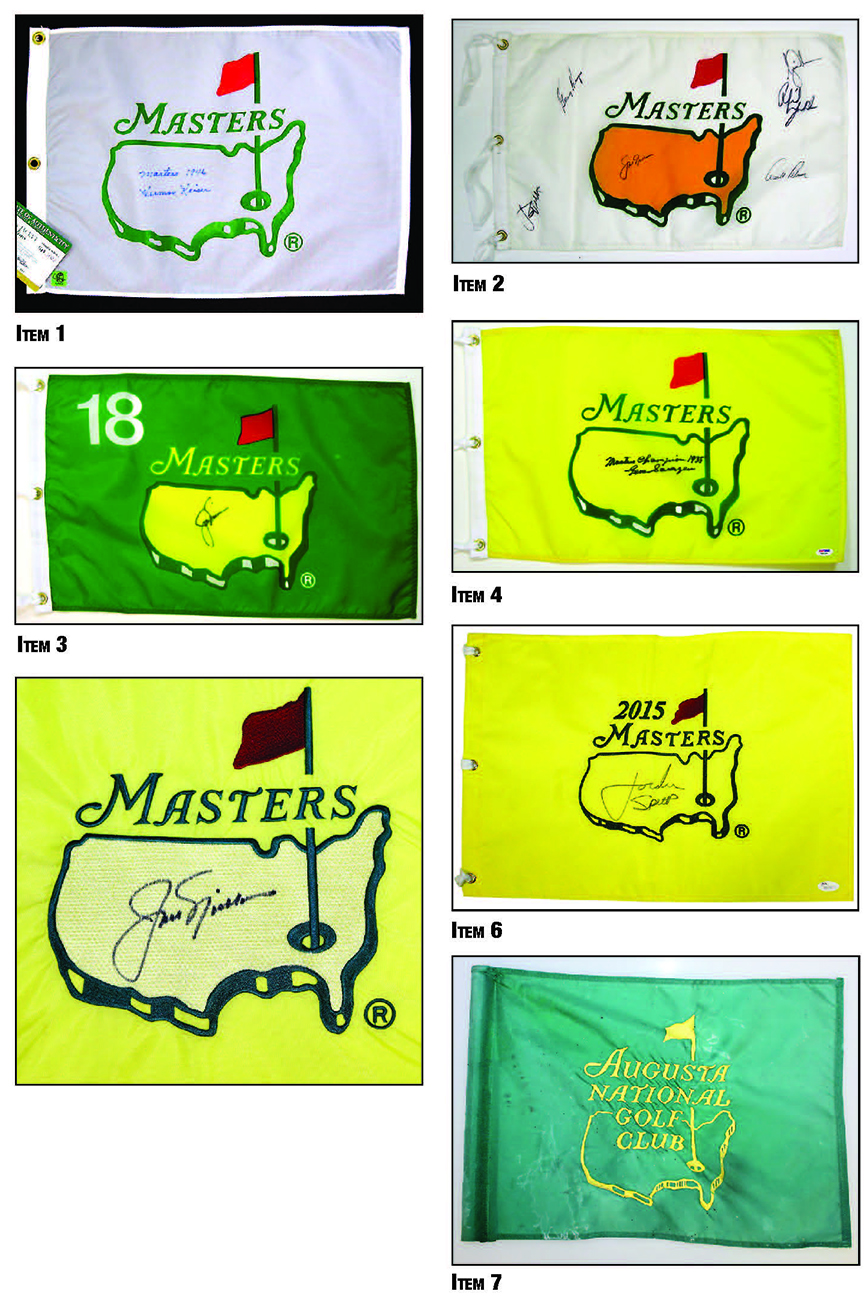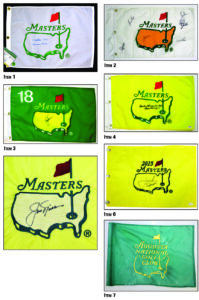
By George Petro
GCS Bulletin – June 2018
Hands-on live auctions in the U.S. and Great Britain, and the GCS shows, once were the primary collector learning centers. Today, the images and descriptions in the internet auctions have become my newest teachers. I enter an auction site in hopes of finding that elusive piece that my collection “craves,” but I am struck by multiple pages of items that have never been on my radar, about which I know very little, and which serve to remind me there are many hundreds if not thousands of avid and active golf collectors not associated with our Society.
As I’m writing this in April, I want to focus on Masters flags, an auction niche about which I’m a complete newbie. My information is gleaned both from auctions and from mastersflags.com. Grouped, framed flags can make a striking display, particularly in our “man caves.” Flags of other Majors also are colorful and collectible, but the Masters leads the way.
Today’s familiar yellow Masters flags did not exist in the early 1990s. In fact only about 100 “unofficial” privately produced flags existed. They were white with a Masters logo in green outline, intended to have prior winners sign them. An example (Item 1) is Green Jacket Auctions (GJA) Lot 336 signed by 1946 winner Herman Keiser, which sold in 12/17 for $1,290.
In 1993 the first official Augusta-produced flags appeared for sale. They, too, were white but had a full orange logo. GJ sold such unsigned flags in 2011 for $577; 2012 for $930; and in 2015 Lot 71 (Item 2) signed by six prior winners (Woods, Speith, Nicklaus, Palmer, Player and Mickelson ) for $1,500.
In 1994, emerald green flags were sold in the tournament merchandise tent. Lot 225 (Item 3) signed by Jack Nicklaus sold at GJA for $513 this April.
Yellow flags probably appeared in 1995 (GJA sold a signed Gene Sarazen example for $1,890 (Item 4). Early flags, based on construction, are referred to as lightweight flags and have more of a tendency for signature bleeding. The yellow 1997 flag became a favorite with its highly desirable cream colored centrally embroidered logo. While it originally sold for $18, prices soared to $4,000 for unsigned examples (about 1997).
Fakes, though readily apparent to experts, contributed to diminishing values.This 1997 Nicklaus-signed example (Item 5) sold this month for $1,100 at The Golf Auction (TGA). 1998 flags were not centrally embroidered. All of these versions and later limited edition undated flags are favorites for signatures. Unsigned flags can be more desirable to one searching for a specific signature(s) than some signed flags. As always, rarity, condition and your trust in various signature authentication services are key considerations unless you get them yourself. Tiger Woods signed flags are available though there are many fakes. He often signs upside down. Tom Watson signed masters flags are quite rare.
Dates on the flags became the norm in 1999 though undated flags have since been produced intermittently with limited availability. Note that flags pre-1999 use a solid band along the southern border of California on the outline map of the U.S., but later have two open spaces there as in the 2015 Speith-signed flag (Item 6) sold at TGA for $1,440. An exception are variable borders on flags intended for on-course use.
The rare course- or tournament-used flags will have a plastic tube under the margin instead of grommets, though beware of reproductions. TGA Lot 25 (Item 7, previous page) is a green course-used flag that recently sold for $4,400. Most green flags are from the practice range. There are some vertically oriented modern flags called “Garden Flags” not uncommonly seen.
For perspective, regarding this month’s auctions; of the 842 lots at GJA, 73 were Masters flags and 34 Masters tickets/badges. Of 600 lots at TGA, 47 were Masters flags and 78 tickets/badges, as well as significant quantities of like items from the other three majors and sporadic others.

Masters tickets have been produced since the inaugural in 1934 and collectors are numerous, hence a 1934 pristine blue tilted square Sunday ticket (above) sold this month at TGA for $116,000. In the past a 1934 full week rectangular paper badge was consigned to, but unsold by, GJA with the description that there were only three known examples of that type.
Among the numerous other tickets sold, a 1941 Master ticket sold for $5,300 in top condition while one with a subtle crease went for $2,500. Rarity and condition!
Other Auction Notables
Sam Snead’s Masters Clubhouse trophy was sold by GJA for $333,000 (they sold Arnold Palmer’s in 2016 for $444,000). The availability of such trophies is very limited because only winners since 1993 and a few prior winners still living at that time, such as Palmer and Snead, received them. Less well known is that two considerably larger versions exist (45 pounds vs 12 pounds) that were meant for museum display.
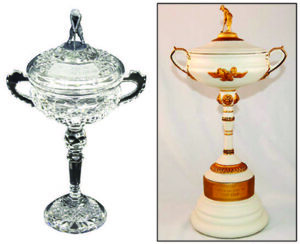
A number of Ryder Cup trophies belonging to players or to associated officials have sold over the past several years from $12-$30,000. Deanne Beaman has just sold a number of personal items for charity including an official 1991 Ryder Cup Trophy given to him as the then PGA Commissioner. This 3/4-size gold finished replica of the 1927 original was sold by TGA for $21,850.
Less well known is that the 1987 Ryder Cup was held at Muirfield in Ohio where course host Jack Nicklaus prepared some special gifts including a beautiful crystal replica of the cup, (top, on left) one of which went to Beman and recently sold for $16,200. A little research showed that in the past, TGA has sold two ceramic versions (photo top right), also labeled 1987 Muirfield, for under $6,000.
Pacific Book Auctions (PBA) sold a copy with some repairs and relatively modern covers of the Black Acts for $1,140. It was the 1566 first printed edition of the 1457 first reference to golf in dark bold black ink, hence the “Black” Acts of Parliament version. In the 1990s pristine copies of the first edition could bring $20,000 and the 1597 second edition nearly $5,000 in near original condition.
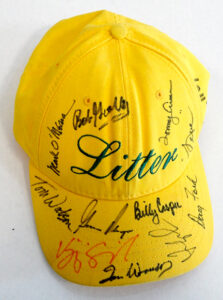
Pure Golf Auctions had a variety of items in its recently completed sale, but I was struck by a signed Masters “Litter” hat (below, left) that sold for $2,900. Such hats are called “Litter Boy Hats” since they and yellow coveralls were worn by young locals hired by Augusta to remove litter from the grounds during the tournaments. GJA notes that in 2009 the color was changed to black, which essentially precludes signatures. This particular hat included the names of Watson, Casper, Player, Couples, and Ballesteros. By contrast, a signed yellow “litter” hat that included Tiger Woods and other signatures sold for just $300 in 2009.
Finally a Crolf Duplex club (below) was patented by John Wilson in 1925 and sold at GJA for $776. An apparent putter/lofter, possibly to be used as a hybrid between croquet and golf?
